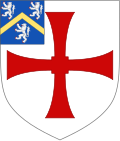Background
Durham University Solar Car is based in the university's School of Engineering, with a team size of around 50 undergraduate students split broadly across mechanical, electrical, electronic and business sub-teams. The team is also strongly supported by graduates and academics within the department with expertise in the fields of solar technology, racing car aerodynamics, direct-drive electrical machines and electrical/hybrid vehicles. Some concepts and features implemented in the vehicles have been developed as part of final year undergraduate projects.
The team was founded as Durham University Solar Car (DUSC) in 2002, and it built its first vehicle in 2004. [2]
Competitive History
DUSC's first competitive event was the 2008 North American Solar Challenge in which they finished 14th out of 26 competitors, earning the “Best Rookie Team” award. [3] They were the only British team to compete. DUSC also competed in the 2011 Veolia World Solar Challenge race across Australia, qualifying in the top ten & then finishing 33rd out of 42 entrants. [4]

In 2014 Durham University Solar Car combined with Durham University Formula Student to create Durham University Electric Motorsport (DUEM). DUEM developed a new solar powered vehicle called DUSC 2015, paying homage to the design work carried out while the team was still known as DUSC - DUSC 2015 competed in the 2015 Bridgestone World Solar Challenge.
In 2017, the team headed back to Australia to compete once more with a modified version of DUSC 2015, showing an improvement in performance and completing more than 1000 km on solar power.
In 2019 the team developed Ortus. They competed with this car at the World Solar Challenge, building further on their results of previous events by finishing 14th.
In 2020 the team were planning to attend the 2020 iLumen European Solar Challenge. Due to the COVID-19 pandemic, the team pulled out of competition, but held a hybrid event at RAF Ouston, aiming to complete the distance from their home in Durham, United Kingdom, to Circuit Zolder, Belgium, in the same 24 hours as the official race was being held. [5] This earnt them recognition by organisers in Belgium, who awarded the team the "Hybrid Challenge Award" for their ingenuity.
In 2022, the team rebranded to Durham University Solar Car [6] to represent a closer tie to the university's Department of Engineering, and to reflect an increased focus on solar car design, having not competed in Formula Student in many years. Under the new name, the team developed a new car with the aim of competing in the 2023 Bridgestone World Solar Challenge. The team then attended the event with this new car.
In 2024 the team competed in its first European Solar Challenge, taking a modified 2019 car. [7]
Outreach
The Team also participates in local community and awareness outreach events, including touring schools [8] and museum exhibitions [9] to promote science, technology and engineering. In 2010, the team ran a successful demonstration event [10] with Cambridge University Eco Racing (CUER).
Due to the COVID-19 Pandemic continuing to prohibit the team from travelling internationally to events, they organised a second outreach campaign, Solar Tour UK (STUK). [11] The team toured UK schools with their car, Ortus, delivering outreach session to students at each school. CUER were again invited, alongside UoN Racing Team and Ardingly Ilfield Solar, to a joint exhibition at Dunsfold Aerodrome at the end of the tour.

